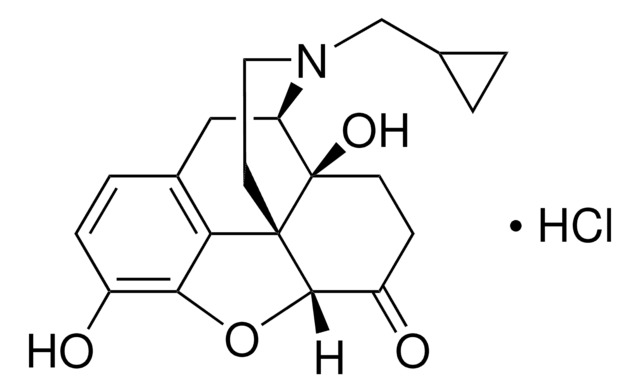N129
Naloxone methiodide
≥98% (HPLC), solid
Sinónimos:
(5α,17R)-4,5-Epoxy-3,14-dihydroxy-17-methyl-6-oxo-17-(2-propenyl)-morphinanium iodide, N-Methylnaloxonium iodide
About This Item
assay
≥98% (HPLC)
form
solid
drug control
regulated under CDSA - not available from Sigma-Aldrich Canada
color
white to tan
solubility
H2O: >10 mg/mL
storage temp.
2-8°C
SMILES string
[I-].[H][C@]12Oc3c(O)ccc4C[C@@H]5[C@](O)(CCC1=O)[C@@]2(CC[N@+]5(C)CC=C)c34
InChI
1S/C20H23NO4.HI/c1-3-9-21(2)10-8-19-16-12-4-5-13(22)17(16)25-18(19)14(23)6-7-20(19,24)15(21)11-12;/h3-5,15,18,24H,1,6-11H2,2H3;1H/t15-,18+,19+,20-,21?;/m1./s1
InChI key
ICONPJDAXITIPI-UXYWFNEESA-N
Application
Biochem/physiol Actions
signalword
Warning
hcodes
Hazard Classifications
Eye Irrit. 2 - Skin Irrit. 2 - STOT SE 3
target_organs
Respiratory system
Storage Class
11 - Combustible Solids
wgk_germany
WGK 3
ppe
dust mask type N95 (US), Eyeshields, Gloves
Certificados de análisis (COA)
Busque Certificados de análisis (COA) introduciendo el número de lote del producto. Los números de lote se encuentran en la etiqueta del producto después de las palabras «Lot» o «Batch»
¿Ya tiene este producto?
Encuentre la documentación para los productos que ha comprado recientemente en la Biblioteca de documentos.
Los clientes también vieron
Nuestro equipo de científicos tiene experiencia en todas las áreas de investigación: Ciencias de la vida, Ciencia de los materiales, Síntesis química, Cromatografía, Analítica y muchas otras.
Póngase en contacto con el Servicio técnico

![[D-Ala2, N-Me-Phe4, Gly5-ol]-Enkephalin acetate salt ≥97% (HPLC)](/deepweb/assets/sigmaaldrich/product/structures/227/014/768064c2-9ae6-47bd-8550-e2aa5c3b61de/640/768064c2-9ae6-47bd-8550-e2aa5c3b61de.png)
